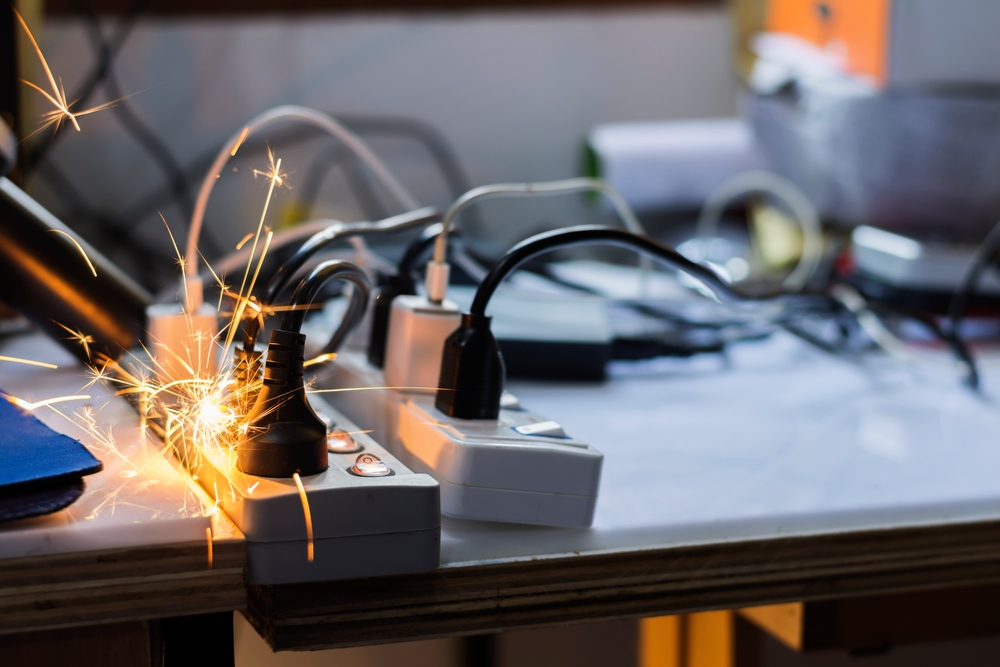Back to Basics is a weekly feature that highlights important but possibly overlooked information that any EHS professional should know. This week, we examine the most common causes of electrical injuries and how to avoid electrical hazards.
Electrical hazards are present in all kinds of industries, and working with electricity or near electrical equipment can often be very dangerous. According to OSHA, many workers are unaware of the potential electrical hazards present in their work environment, which increases their likelihood of getting electrocuted. The following are the hazards that cause electrical injuries most frequently.
Contact with power lines
According to OSHA, overhead and buried power lines at a worksite are especially hazardous because they carry extremely high voltage. Fatal electrocution is the main risk, but burns and falls from high places are also hazards. The tools and equipment used to contact power lines also increases the risk for electrocution. This equipment includes the following:
- Aluminum paint rollers
- Backhoes
- Concrete pumpers
- Cranes
- Long-handled cement finishing floats
- Metal building materials
- Metal ladders raised dump truck beds
- Scaffolds
Employers should make sure that their employees avoid hazards from power lines by posting warning signs and making sure they check for overhead power lines and buried power line indicators. They can also contact utilities for buried power line locations.
Workers must stay at least 10 feet away from overhead power lines, and assume that unless otherwise informed, the power lines are energized. Ground lines should be de-energized when employees are working near them, and other protective measures should include guarding or insulating the lines. Be sure to use non-conductive wood or fiberglass ladders when working near power lines.
Lack of ground-fault protection
Due to the ever-changing nature of construction work, normal use of electrical equipment at your site causes wear and tear, resulting in insulation breaks, short circuits, and exposed wires. If there is no ground-fault protection, these can cause a ground fault that would send a current through the worker’s body, causing electrical burns, explosions, fire, or death, OSHA states.
To avoid ground-fault hazards, employers should require the use of ground-fault circuit interrupters (GFCI) on all 120-volt, single-phase, 15- and 20-ampere receptacles, or have an assured equipment grounding conductor program (AEGCP) in place. Follow the manufacturer’s recommended testing procedure to make sure the GFCI is working properly.
Distinctly marked double-insulated tools and equipment should be used according to the instructions included in their listing, labeling, or certification. All equipment must be visually inspected before use, and it must be removed from service if it has any frayed cords, missing ground prongs, cracked tool cases, or other defections. Apply a warning tag to any defective tool and do not use it until the problem is resolved.
Missing or discontinuous path to ground
If the power supply to the electrical equipment at a worksite is not grounded or the path has been broken, fault current may travel through a worker’s body, once again causing electrical burns or death. Electrical equipment can instantly change from safe to hazardous because of extreme conditions and rough treatment, even when the system is properly grounded.
OSHA recommends that workers ground all supply systems, electrical circuits, and electrical equipment, and frequently inspect electrical systems to ensure that the path to the ground is continuous. All electrical equipment must be visually inspected before use, and any equipment that is defective must be taken out of service.
Workers should not remove ground plugs from cord- and plug-connected equipment or extension cords, and they should only use distinctively marked double-insulated tools and equipment. All the metal parts of equipment should be grounded, along with the metal parts of the following non-electrical equipment:
- Frames and tracks of electrically operated cranes
- Frames of non-electrically driven elevator cars to which electric conductors are attached
- Hand-operated metal shifting ropes or cables of electric elevators
- Metal partitions, grill work, and similar metal enclosures around equipment of over 1kV between conductors
These non-electrical equipment parts have been specified by OSHA’s electrical standard 29 CFR 1926.404(f)(7)(v).
Equipment misuse
If electrical equipment is used improperly in ways for which it is not designed, workers can no longer depend on the safety features built in by the manufacturer. This can damage the equipment and cause the user injuries. OSHA provides some common examples of equipment misuse, including using indoor equipment outside, attaching two-prong adapter plugs to three-prong cords and tools, using modified cords or tools, or using tools with worn insulation or exposed wires.
All equipment used on the jobsite must be approved to meet OSHA standards, and it must be used according to the manufacturer’s instructions. Employers must instruct workers not to modify cords or use them incorrectly, and make sure that if any equipment has been shop-fabricated or altered is still in compliance.
Improper use of cords
The normal wear and tear on extension and flexible chords at a jobsite can loosen or expose wires, creating electrical hazards, says OSHA. Cords that are not 3-wire type, not designed for hard usage, or that have been modified, increase an employee’s risk of coming into contact with an electrical current.
Only the following types of cords should be used at a jobsite:
- Factory-assembled cord sets
- Extension cords that are 3-wire type
- Extension cords that are marked with a designation code for hard or extra-hard usage
- Cords, connection devices, and fittings that are equipped with strain relief
All cords should be removed from receptacles by pulling on the plugs, not the cords. Employers must be sure to continually audit cords on-site, and any cords found to be modified or not marked for hard or extra-hard use must be removed from service immediately.
For more information on electrical hazards and OSHA’s standards, click here.

